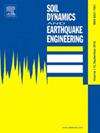Simplified site response analysis for regional seismic risk assessments
IF 4.2
2区 工程技术
Q1 ENGINEERING, GEOLOGICAL
引用次数: 0
Abstract
Seismic risk assessment on a regional scale requires an estimation of ground motion intensity and its spatial variation over large geographical areas. This task is particularly challenging in the presence of very soft soil deposits where significant amplification occurs at specific frequencies that are often referred to as local resonances. It is often not feasible to conduct a nonlinear site response analysis at thousands of sites of interest across a region such as an urban area due to the computational effort involved and the required detailed information on soil profiles at each site. Thus, in regional seismic risk analyses the hazard is typically represented by a field of response spectral ordinates estimated by ground motion models. This study proposes a simplified site response analysis procedure to improve the characterization of spectral ordinates to be used in regional seismic risk assessments. In the proposed procedure, reduced-order models are used to conduct site response analysis using very few parameters to transform response spectra at rock outcrop into response spectra at the surface of each of the sites. A particular emphasis is given to soft-soil sites characterized by low shear-wave velocities overlaid on rock or firm soils. A non-uniform continuous shear beam model with a parabolic variation of shear modulus along the depth and modal damping is used in combination with Random Vibration Theory. It is shown that the proposed approach provides better estimates than those of ground motion models or physics-based ground motion simulation models which often cannot capture the local resonances. Site-specific validation of the shear beam model and overall simplified site response analysis is performed at four soft-soil sites in San Francisco, California. Despite its simplicity, it is shown that the proposed procedure adequately captures the amplitudes and spectral shapes of the motions. It is also shown that in conjunction with ground motion models or physics-based models, the proposed simplified site response analysis procedure can be used to efficiently simulate the seismic hazard on a regional scale through an example of a regional seismic hazard analysis of 160 softer soil sites in Downtown San Francisco during the Loma Prieta earthquake.
用于区域地震风险评估的简化场地响应分析
区域范围的地震风险评估需要估算地动强度及其在大面积地理区域内的空间变化。在存在非常松软的土壤沉积的情况下,这项任务尤其具有挑战性,因为在特定频率下会出现明显的放大现象,这通常被称为局部共振。由于计算工作量大,而且每个地点都需要详细的土壤剖面信息,因此在城市地区等区域内对数千个相关地点进行非线性场地响应分析通常是不可行的。因此,在区域地震风险分析中,通常用地动模型估算的响应谱序数场来表示危险。本研究提出了一种简化的场地响应分析程序,以改进区域地震风险评估中使用的频谱序号的特征描述。在建议的程序中,使用简化阶模型进行场地响应分析,使用极少的参数将岩石露头处的响应谱转化为每个场地表面的响应谱。特别强调的是软土场地,其特点是岩石或坚硬土壤上的剪切波速度较低。结合随机振动理论,使用了剪切模量沿深度抛物线变化和模态阻尼的非均匀连续剪切梁模型。结果表明,与通常无法捕捉局部共振的地面运动模型或基于物理的地面运动模拟模型相比,所提出的方法能提供更好的估算结果。在加利福尼亚州旧金山的四个软土场地对剪力梁模型和整体简化场地响应分析进行了特定场地验证。结果表明,尽管程序简单,但所建议的程序能够充分捕捉到运动的振幅和频谱形状。此外,通过对洛马普列塔地震期间旧金山市中心 160 个软土场地进行区域地震危害分析的实例还表明,结合地面运动模型或基于物理的模型,所提出的简化场地响应分析程序可用于有效模拟区域范围内的地震危害。
本文章由计算机程序翻译,如有差异,请以英文原文为准。
求助全文
约1分钟内获得全文
求助全文
来源期刊

Soil Dynamics and Earthquake Engineering
工程技术-地球科学综合
CiteScore
7.50
自引率
15.00%
发文量
446
审稿时长
8 months
期刊介绍:
The journal aims to encourage and enhance the role of mechanics and other disciplines as they relate to earthquake engineering by providing opportunities for the publication of the work of applied mathematicians, engineers and other applied scientists involved in solving problems closely related to the field of earthquake engineering and geotechnical earthquake engineering.
Emphasis is placed on new concepts and techniques, but case histories will also be published if they enhance the presentation and understanding of new technical concepts.
 求助内容:
求助内容: 应助结果提醒方式:
应助结果提醒方式:


